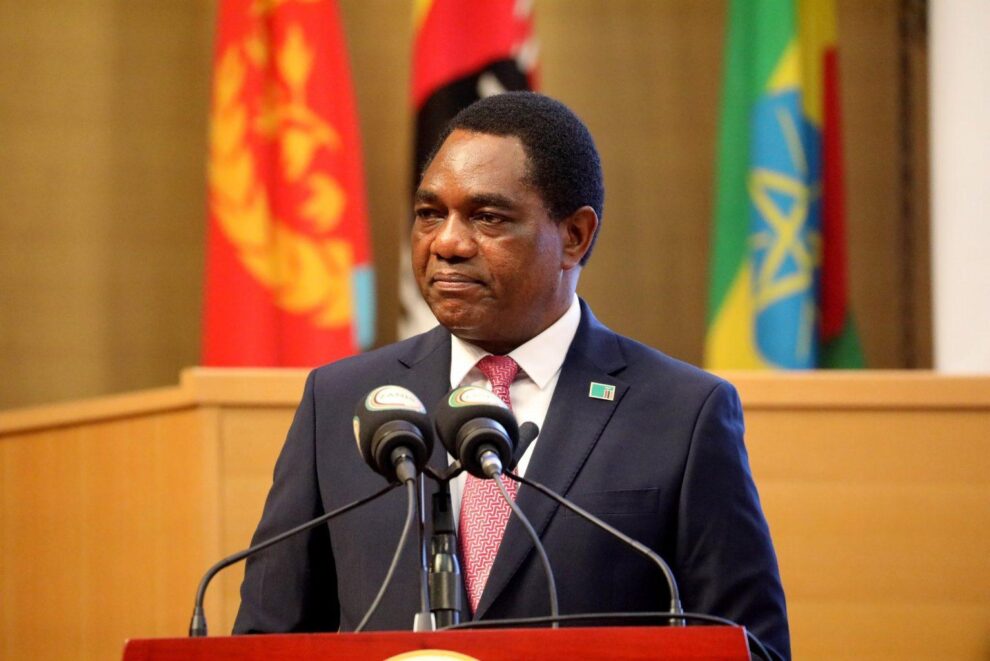ON 11th November 1965, white settlers in the then British territory of Southern Rhodesia, present-day Zimbabwe, led by Ian Douglas Smith, declared their ‘independence’ from Britain. Suddenly the newly-independent neighbouring state of Zambia under the leadership of President Kenneth Kaunda and his UNIP comrades had to contend with a major logistical headache.
What was this major logistical headache and how does it relate to the Lobito Corridor Concession that took President Hakainde Hichilema to neighbouring Angola’s Benguela Province to actively participate in its actualisation on Tuesday, July 4 2023?
When Rhodesian prime minister Ian Smith declared the Unilateral Declaration of Independence (UDI) in 1965, exactly a year after Zambia got her independence from Britain, the move had both political and economic ramifications for the infant African state given its landlocked geographical position within Central and Southern Africa. The declaration of the UDI in Southern Rhodesia closed a vital access to the sea for Zambia via the Port of Durban in South Africa. Politically, the consequences from the UDI was such that with a white settler-led government in Southern Rhodesia, two racially-inspired regimes, given that South Africa was then also being led by a minority Afrikaner regime which had declared the racially-based system of Apartheid in 1948, stood in the way of the newly-independent Zambia’s economic emancipation albeit the freshly gained political independence from Britain. Therefore, in response to this glaring emergency situation, the Kaunda-led UNIP administration had to look elsewhere for Zambia’s exports and imports to have an outlet and inlet via the sea. Without this artery, the UNIP-led government’s desire to move the country to desirable economic heights were to be condemned to a spirited effort in futility.
To this effect, eyes were cast towards South West Africa, present-day Namibia, which unfortunately was annexed by apartheid South Africa at the time. Considerations on Angola and Mozambique in this regard, could equally only last longer than dew in the midday heat. These two African territories were under Portuguese colonial rule and it was unthinkable that the racist regimes in Angola and Mozambique could entertain the overtures of a newly-independent African state of Zambia to access the Indian and Atlantic oceans via these territories. With eyes cast wider, the UNIP administration had to look East, towards the equally newly-independent nation of Tanzania, formerly Tanganyika. It was then that the question of how Zambia was going to deal with the UDI political and economic headache was ‘resolved’ through the Hell Run or Great North Road as we know it today. But was this resolution conclusive? Thus, when President Hichilema, the seventh from President Kenneth Kaunda, boarded that flight for the port town of Lobito in Angola’s Benguela Province on Tuesday, July 4, 2023, to join his Angolan counterpart, President João Goncalves Lourenço, and their Congolese counterpart, President Chilombo Tshisekedi, to officially launch the Lobito Corridor Concession, he was not only re-emphasising the now healthy Angola/Zambia bilateral relations, but stepping into our founding fathers’ big shoes of providing sound leadership in resolving a 58-year-old major logistical headache of charting the shortest route to the sea for Zambia. Concessioning of the Lobito Corridor In July, 2022 the Angolan Government concessioned the Lobito Corridor to a consortium of three companies; Trafigura of Switzerland , Mota Engil of Portugal, and Vecturis of Belgium operating as an SPV (Special Purpose Vehicle). The concessionaire (SPV) will be responsible for the operation, management, and maintenance of the 1067mm gauge railway (cape gauge) infrastructure for the transport of goods, minerals and passengers, liquids and gases. The concession period is 30 years and the concessionaire has agreed to invest US$100 million in the initial stage – US$170 million for infrastructure and US$170 for rolling stock. The concessionaire will pay US$319.4 million to the Angolan Government in the first 10 years, US$787 million in the second 10 years, and US$919 million in the last 10 years. Trafigura and Mota Engil will both hold 49.5 percent each while Vecturis will hold one percent and will be responsible for operating the railway, benchmarking on its railway business acumen in Europe. Mota Engil, on the other hand, will be responsible for infrastructure maintenance, while Trafigura will be responsible for commercialisation. Lobito Corridor Economies of Scale Angola has completed the modernisation of the Port of Lobito in response to anticipated increased volumes of cargo after completing the upgrading ad reconstruction of the Benguela Railway line. The berthing capacity, the stowage and cargo handling and storage capacity has increased. Currently the Port of Lobito has 7.8 kilometres of berthing area, i.e able to handle 20 big ships of up to 15.2 metres draught. Cargo handling capacity increased to 11 million tonnes of general merchandise and 700,000 TEUs per year. Furthermore, they have invested in Tugs, boat pass, cables among others. Additionally, a container terminal, mineral terminal, grain terminal and fuel terminal are in separate locations within the port. The modernisation has tremendously increased the ports thorough put. Again, the Lobito Corridor is not only the shortest route to the sea for Zambia but a logistical enabler for the country’s imports and exports. Hitherto and presently, Zambia’s traditional export routes include Dar-es-Salaam, a distance of 2,200 km, and Durban post-1994, a distance of 2,300 km. But the distance to Lobito is 1, 344 km. Hence, the significance of President Hichilema’s one-day visit to Angola to actively participate in the actualisation of the Lobito Corridor Concession. Benguela Railway Company The capacity of the Benguela Railway Company has continued to improve. The company has a fleet of general electric locomotives with a 3,300 horse power each. The locomotives have the capacity to pull 38 wagons. Each wagon can carry 40 tonnes. Simple arithmetic, one train can carry 1520 tonnes at once compared to trucks on the road which can only carry 30 tonnes at once. The locomotives are able to run at 100km per hour at optimum speed. The company also has different types of wagons to carry different types of cargo, flat beds to carry containers and minerals, tankers to carry fuels, side drops to carry grains and general cargo. Infrastructure of the Lobito Corridor The infrastructure of the Lobito Corridor include the Port of Lobito, Benguela Railway line, the Angola/ Zambia border posts, the Angola/DRC border posts and the attendant transport infrastructure on the Zambia and DRC sides. Angola, Zambia and DRC in this context are the member states of the Lobito Corridor. Importance of Lobito Corridor to Zambia • The Lobito Corridor remains the shortest route to the sea for Zambian imports and exports;
• Will reopen the once operational business corridor, giving Zambia preferential advantage to choose from the other available corridor options;
• Lobito Corridor has been peaceful and stable since the end of the Angolan civil war in 2002;
• Unlock the business potential along the corridor through effective participation of small and medium enterprises in transport and logistics value-chain;
• Boost private sector investments, create jobs, and foster economic growth in DRC Zambia and Angola;
• Easy movement of people, goods and services;
• Enhance cross-border coordination in the planning and development of infrastructure;
• Lower operating costs and reduce travel time for transporters;
• Improve and stimulate regional connectivity and integration through the implementation of the harmonised trade facilitation instruments, transport policies, laws, regulations and standards for efficient cross-border transport , transport and logistics services, systems and procedures; and
• It will reduce pressure on the Solwezi-Chingola road from damage, as transportation of copper from the area will be done by railway.
Status of transport infrastructure in the three Lobito Corridor member States
Angolan Side: Angola has modernised the Port of Lobito with ability to handle different types of cargo among them grains, minerals, containers, and fuels. Angola has also constructed a 1,344 km of rail from the Port of Lobito to the DRC border town of Luau. The Port of Lobito has been transformed into a multi-modal transport hub complete with an international airport, road infrastructure, port and railway.
To connect to Zambia, a project to build a loop railway line from Luacano town in Moxico Province and link to Zambia through Jimbe border in the North-Western Province is in the pipeline. The Concessionaire (SPV) has expressed interest to develop this loop railway to the Zambian border and also build the Zambian part too. The investor has, however, put a condition of increasing the concession period by another 20 years if the proposal is accepted by the governments of Zambia and Angola.
DRC Side: The DRC has an existing railway line that runs through from Luau, Angola through to Tenke, Lubumbashi to Kasumbalesa to Chililabombwe on the Zambian border. The railway line is however in a deplorable state and requires a total revamp
Zambian Side: Construction of the North West Rail by North West Rail Company Ltd, a Greenfield Railway project from Chingola – Solwezi- Kalumbila – Jimbe with a total of 550 km has stalled. The project design is based on Cape gauge. The project has fallen behind schedule as no works have taken place in 20 years.
With regard to roads, the development of the road network is equally behind schedule and in a deplorable state. Among these roads include the Solwezi-Mutanda-Mwinilunga- Jimbe one. There is also need to construct a one-stop border post at Jimbe. Angola has announced its intention to build part of the road from Jimbe to Cazombo then connect on an already existing road to Benguela Railway using direct financing from the treasury. On the Zambian side, Government is scouting for a private partner to execute the project under the public private partnership (PPP) financing model.
So far, according to Minister of Infrastructure, Housing and Urban Development Charles Milupi, in a ministerial statement recently delivered before Parliament, several local and international private firms have expressed interest to undertake this international road project.
Benefits of Concessioning Lobito Corridor
• Through this concession, the public infrastructure of the corridor is placed in the hands of the private sector for 20 years, will unlock investment into the corridor infrastructure which in turn will attract increased traffic volumes;
• Placing the infrastructure of the corridor under the control of a private entity will create synergies to the corridor operations;
• The concession will increase the level of competitiveness and integration of the corridor into the regional and global chains ;
• The concessioning from public to private will act as a multiplier effect on the economies of Angola, DRC and Zambia through main-streaming of the efficiencies that private sector brings to the corridor;
• Concessioning of the corridor infrastructure will result in the reduction of the state’s financial burden on investment in the modernisation of the corridor infrastructure;
• The concessioning of the Port of Lobito, where goods and passengers are transferred from ship to land will result in increased efficiencies brought to the fore by the private sector;
• A fully functional corridor will generate jobs, will impact on household incomes, will revolutionise leisure and cultural tourism activities;
• Transfer of technology and knowhow;
• Attract private financing for large and indivisible investments in corridor transport infrastructure, machinery and equipment.
Conclusion
In establishing sound bilateral relations with Angola and guiding Zambia back into the Lobito Corridor, President Hichilema and his new dawn administration is not only vigorously tackling an age-old economic conundrum, which in a bigger way held back the nation’s total economic emancipation 58 years after political independence, but he is also setting on a path of full-scale economic resuscitation while drawing lessons from historical experiences. Like the recent clinching of the debt restructuring deal, the actualisation of the Lobito Corridor Concession, all fruits of economic diplomacy, is one of the many reasons President Hichilema’s foreign trips are justifiable.
The author is a media practitioner and development communication consultant.
Source: Zambia Daily Mail Limited











